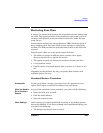
Backup
Managing Failed Backups
Chapter 5 265
If a backup of an object fails to start, Data Protector tries to back up this
object again at the end of the backup session. If it fails again, the object
is not backed up, and the status of the object and the session is set to
Failed. A backup is repeated when it is scheduled. If some objects finish
properly, the session status is completed with failures.
Clients that are not up and running when they are scheduled to be
backed up are retried after the rest of the objects are completed. Before
the first failed object is retried, the backup session is suspended for 30
seconds. This waiting time can be changed using the WaitBeforeRetry
global option. See “Global Options File” on page 523 for information on
how to change global options.
IMPORTANT If you have an infrequent backup schedule, this may result in a period of
time when there is no recent backup of your data.
NOTE Data Protector always needs one full backup of data. If no protected full
backup is available, a full backup will be done next time, even though an
incremental backup was scheduled. To avoid this, run a full backup of
the failed system interactively before you schedule a backup.
For details on full and incremental backup behavior, see the HP
OpenView Storage Data Protector Concepts Guide.
When you configure a backup, you can use the Reconnect Broken
Connection option. When this option is set, Data Protector reconnects
the Backup Session Manager and Disk or Media Agents in the case of
short-term network problems during a backup session. This often
happens on unreliable LAN networks.
Enabling Wake ONLAN Support
If you have any machines that support remote power-up (Wake
ONLAN), you can use the Data Protector Wake ONLAN support. When
a Backup Session Manager fails to connect to a client that is configured
to use Wake ONLAN support, it sends a wake-up request according to
the Wake ONLAN protocol, and retries connecting to the client. This
allows the full use of the power-saving features of desktop systems,
which would otherwise interfere with the backup process.


















